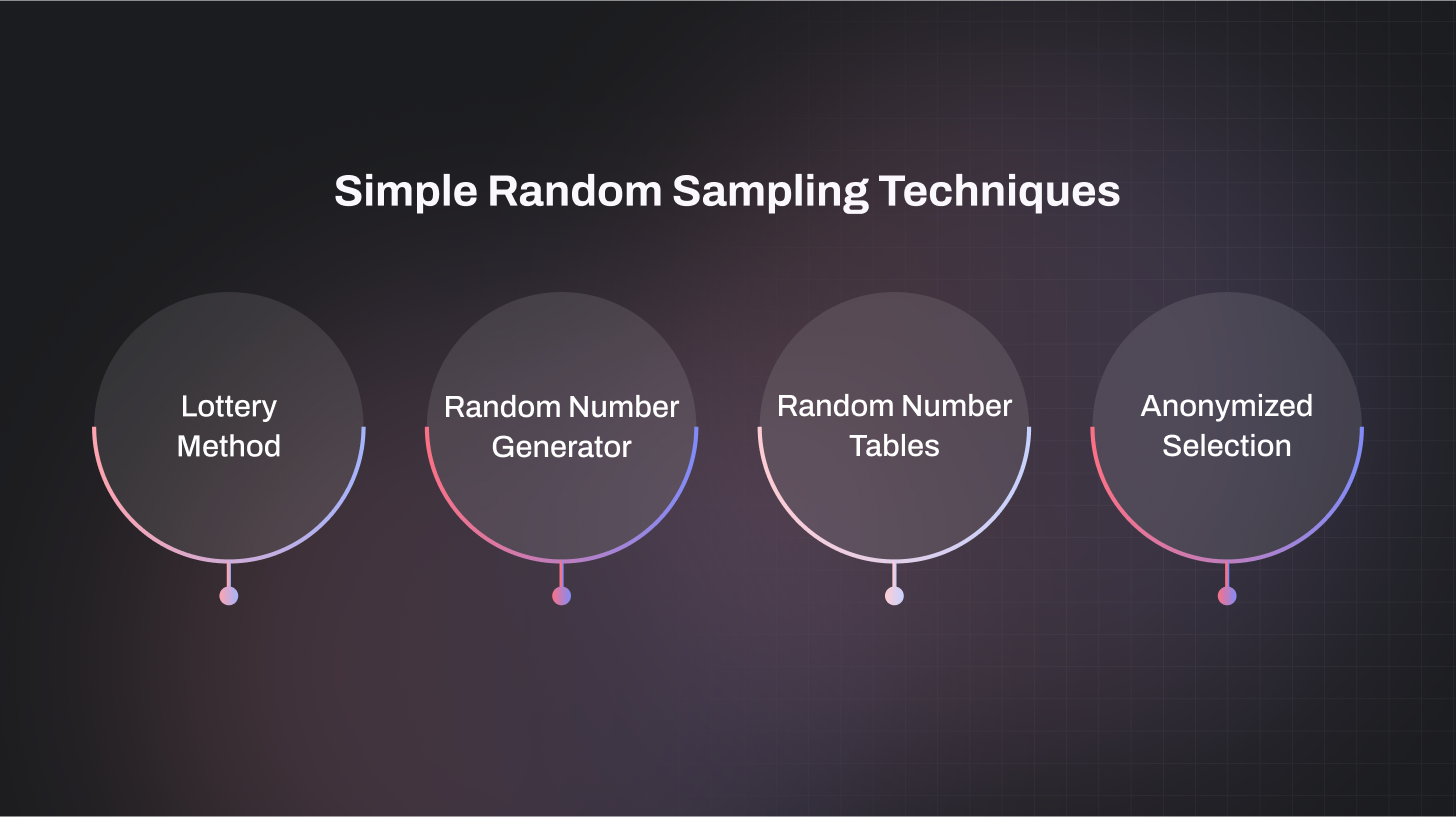 Blog
Blog A Complete Guide to Random Sampling Methods and Techniques
A Complete Guide to Random Sampling Methods and TechniquesA Complete Guide to Random Sampling Methods and Techniques

Ever wondered how pollsters predict election results with just a fraction of the population? Or how researchers get reliable data without surveying everyone? The answer lies in random sampling techniques.
Random sampling is one of the most powerful tools in business and research because it ensures that every individual in a population has an equal chance of being selected. This approach minimizes bias, improves accuracy, and gives companies the confidence that their insights represent the real picture, not just the loudest voices.
In this guide, we’ll break down the most common types of random sampling methods, explain their techniques, and share real-world examples to help you apply them effectively.
What is Random Sampling?
Random sampling is a method in which a smaller subset (sample) is chosen from a larger group (population) in such a way that every individual has an equal chance of being selected. It is considered one of the most straightforward probability-based sampling techniques.
Because the selection is completely random and based on probability, the sample usually reflects the larger population more accurately and reduces the risk of researcher bias. For this reason, it is sometimes referred to as the "method of chances."
Let’s understand it with an example.
Suppose a clothing brand has 10,000 online customers and wants feedback on its new summer collection. Instead of only asking recent buyers or loyal customers, the company randomly selects 1,000 customer emails from its entire database using a computer program.
Because each customer had the same probability of being chosen, the feedback is more balanced and reflects the opinions of the whole customer base, not just a specific group.
Read: Everything You Need to Know About Survey Sampling in Research and Business
When to Use Random Sampling
Researchers often turn to simple random sampling when they don’t know much about the population they’re studying. For it to work properly, they must be able to reach every individual in that population so the sample truly represents the whole. Like any method, it brings both strengths and drawbacks.
Advantages of Random Sampling
- Fair chance for all: Everyone in the population has an equal opportunity to be included, which helps eliminate bias and maintains the process's objectivity. This makes it a strong choice for experiments that need neutrality.
- Population representation: Since people are chosen randomly, the smaller group usually reflects the larger one quite accurately, eliminating the need to divide participants into additional sub-groups.
- Practical and affordable: It doesn’t take much time, money, or effort to set up, which is ideal for studies that need to get underway quickly.
Disadvantages of Random Sampling
- Risk of imbalance: Even with random selection, sometimes the sample might not perfectly represent the population, for example, too many similar individuals might get chosen by chance.
- Little researcher influence: Since the process is fully random, there’s no way to adjust the outcome without adding bias. If the sample looks skewed, the best option is usually to run the selection again.
Types of Random Sampling Methods
Simple Random Sampling
Simple random sampling is the most straightforward technique, where each individual in the population has an equal chance of being selected. To carry this out, researchers assign numbers to all participants and then use a random process such as a lottery method, random number tables, or a computer generator to choose the sample.
For instance, if a school has 600 students and the researcher needs 60 for a survey, each student is numbered and a random number generator is used to select 60 names.
This method differs from other approaches because it does not involve subgroups, intervals, or clusters. Selection is purely based on chance, making it unbiased and simple, though less practical for very large populations.
Systematic Sampling
Systematic sampling is a method based on fixed intervals. All participants are first assigned a number, and the researcher randomly selects a starting point. From there, every kth individual is chosen until the sample size is complete.
For example, a researcher wants 100 employees from a list of 1,000. If the 7th person is chosen as the starting point and the interval is 10, then the 7th, 17th, 27th, and so on will be selected.
This approach is easier to conduct than simple random sampling, but the use of intervals means that certain patterns in the population could influence the sample, whereas simple random sampling avoids such risks.
Stratified Sampling
Stratified sampling divides the population into subgroups, or strata, based on shared characteristics such as age, gender, income level, or department. Random samples are then drawn from each subgroup in proportion to their size in the population.
For instance, if a company wants to study salary differences, the workforce may be divided into male and female groups. Random samples are then selected from both groups to ensure that each gender is represented.
Unlike simple random sampling, which selects directly from the entire population, stratified sampling guarantees that all key subgroups are included. However, it requires prior knowledge of population characteristics to create the strata.
Also Read: A Complete Guide to Stratified Random Sampling for Researchers
Cluster Sampling
Cluster sampling also involves dividing the population into groups, known as clusters, but instead of sampling individuals from all groups, entire clusters are chosen randomly. There are two types of cluster sampling: one-stage, where all individuals in the selected clusters are surveyed, and two-stage, where only some participants within the clusters are randomly chosen.
For example, to study student performance in a city, researchers might divide schools into clusters. They then randomly select a few schools and either survey all students in those schools (one-stage) or randomly select students from within them (two-stage).
The difference from simple random sampling is that individuals are not directly selected from the whole population; instead, pre-existing groups are used. While this makes it cost-effective and practical for large or spread-out populations, it may not always provide the same level of representation as simple random sampling.

Common Random Sampling Techniques in Research
When it comes to random sampling, one thing is clear: people can’t simply “make up” random numbers themselves. Human choices are rarely truly random; we often lean toward familiar dates, favorite numbers, or unconscious patterns. To remove that bias, researchers and analysts use structured methods to generate randomness.
Some common approaches include:
- Lottery-style draws: Every person or item in the population is assigned a unique number, which is written on slips of paper or balls. These are then mixed in a container, and selections are drawn blindly.
- Physical devices: Early studies often relied on chance tools such as rolling dice, flipping coins, or spinning wheels, each outcome tied to a population member.
- Pre-made random tables: Many statistics references include pages of random numbers that can be used to guide selection.
- Digital randomizers: Online tools now make it simple to plug in a population size and sample size, instantly generating a randomized list.
- Spreadsheet formulas: Programs like Excel have built-in functions, such as RANDBETWEEN, which can quickly create random values within a set range.
These random sampling techniques ensure that the selection process is objective and unbiased. Today, businesses often go a step further by using AI-driven survey platforms like TheySaid, which automate random selection, remove human error, and deliver insights faster at scale.
Book a demo with TheySaid today and see how AI-powered surveys turn random sampling into reliable, actionable insights.

Also Read: Sampling Error Explained: Definition, Types, and How to Reduce It
Real-World Examples of Random Sampling Methods and Techniques
Random sampling isn’t just a textbook concept. It’s applied across industries every day to generate insights that shape strategy and decision-making.
In politics, polling agencies like Gallup and Pew Research regularly use simple random sampling to predict election outcomes. Instead of surveying millions of voters, they select a carefully randomized subset that mirrors the overall population. This is how news outlets can forecast national results with surprising accuracy, often within a margin of just 2–3%.
In business and marketing, companies often turn to stratified random sampling to ensure representation across customer groups. For example, Starbucks has been known to divide its customer base into segments such as students, working professionals, and retirees, then randomly survey each group. This approach helps the company understand how different demographics perceive its pricing, menu variety, and in-store experience.
In healthcare research, cluster random sampling is widely used to manage scale. A pharmaceutical company conducting a nationwide drug trial might randomly select hospitals in different regions, then survey all patients within those hospitals. This reduces cost and logistics while ensuring the sample still reflects the larger patient population.
In the tech world, platforms like Netflix rely on systematic random sampling to test user experience. Instead of asking all subscribers for feedback, Netflix automatically prompts every 100th user to rate a new feature. This allows them to gather statistically valid insights quickly without overwhelming their audience.
And for large-scale, multi-country studies, researchers often use multi-stage random sampling. For instance, the World Bank applies this method in global surveys where they first select random countries, then provinces within those countries, followed by households, and finally individuals. The result is data that’s both reliable and manageable, even across massive populations.
These examples show how random sampling techniques are not just academic theory but powerful tools in the real world, enabling organizations to gather accurate, unbiased insights while saving time and resources.
TheySaid: Panel-Agnostic and Flexible Sampling
Random sampling works best when you can select the right group of people to respond to your survey, but what if you don’t have your own panel? That’s where TheySaid shines.
TheySaid is panel-agnostic, meaning you can work with any sampling company or panel you prefer. You’re not limited to a fixed group of respondents; the platform adapts to your needs, whether it’s customers, employees, or any target audience.
By combining AI-driven automation with flexible panel integration, TheySaid makes it easy to:
- Run surveys with truly randomized samples
- Gather unbiased, accurate insights quickly
- Scale feedback collection without limits
- Work seamlessly with any panel or sampling provider
With TheySaid, random sampling isn’t just a methodology; it’s a fast, flexible, and reliable way to get insights that actually represent your audience, no matter where your panel comes from.
Ready to see how flexible, AI-powered sampling works in practice? Book a demo with TheySaid and start running smarter, bias-free surveys today.
Key Takeaways
- Random sampling methods ensure every individual in a population has an equal chance of being selected, reducing bias and improving accuracy.
- Common random sampling techniques include lottery draws, dice/coins, random number tables, digital randomizers, and spreadsheet formulas.
- Types of random sampling methods include simple random sampling, stratified sampling, cluster sampling, and systematic sampling.
- These methods are widely used in research, business, polling, and surveys to generate unbiased, representative data.
- Modern platforms like TheySaid take random sampling further with AI-driven automation, panel-agnostic flexibility, and faster insights at scale.
FAQs
What is the difference between random sampling and non-random sampling?
- Random sampling gives each member of the population an equal chance of selection, leading to unbiased results.
- Non-random sampling (like convenience or quota sampling) relies on the researcher's judgment or accessibility, which may introduce bias.
Why is random sampling important in surveys?
Random sampling is important because it minimizes selection bias, increases accuracy, and ensures that survey results reflect the true population rather than just a specific subgroup.
Can AI improve random sampling methods?
Yes. AI platforms like TheySaid remove human error, automate sample selection, and integrate with any panel provider. This makes the sampling process faster, more scalable, and more reliable.
















.svg)